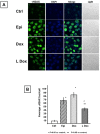Comparative cardiac toxicity of anthracyclines in vitro and in vivo in the mouse
- PMID: 23516478
- PMCID: PMC3597611
- DOI: 10.1371/journal.pone.0058421
Comparative cardiac toxicity of anthracyclines in vitro and in vivo in the mouse
Abstract
Purpose: The antineoplastic efficacy of anthracyclines is limited by their cardiac toxicity. In this study, we evaluated the toxicity of doxorubicin, non-pegylated liposomal-delivered doxorubicin, and epirubicin in HL-1 adult cardiomyocytes in culture as well as in the mouse in vivo.
Methods: The cardiomyocytes were incubated with the three anthracyclines (1 µM) to assess reactive oxygen generation, DNA damage and apoptotic cell death. CF-1 mice (10/group) received doxorubicin, epirubicin or non-pegylated liposomal-doxorubicin (10 mg/kg) and cardiac function was monitored by Doppler echocardiography to measure left ventricular ejection fraction (LVEF), heart rate (HR) and cardiac output (CO) both prior to and 10 days after drug treatment.
Results: In HL-1 cells, non-pegylated liposomal-doxorubicin generated significantly less reactive oxygen species (ROS), as well as less DNA damage and apoptosis activation when compared with doxorubicin and epirubicin. Cultured breast tumor cells showed similar sensitivity to the three anthracyclines. In the healthy mouse, non-pegylated liposomal doxorubicin showed a minimal and non-significant decrease in LVEF with no change in HR or CO, compared to doxorubicin and epirubicin.
Conclusion: This study provides evidence for reduced cardiac toxicity of non-pegylated-liposomal doxorubicin characterized by attenuation of ROS generation, DNA damage and apoptosis in comparison to epirubicin and doxorubicin.
Conflict of interest statement
Figures





Similar articles
-
Enhancing cardiac safety: Liposomal ciprofloxacin mitigates anthracycline-induced cardiotoxicity without compromising anticancer efficacy.Chem Biol Interact. 2025 Jun 1;414:111496. doi: 10.1016/j.cbi.2025.111496. Epub 2025 Mar 27. Chem Biol Interact. 2025. PMID: 40157626
-
Doxorubicin liposomal pegylated: new preparation. Breast cancer: not just a question of short-term cardiac effects.Prescrire Int. 2004 Jun;13(71):90-1. Prescrire Int. 2004. PMID: 15233142
-
In vitro modeling of the structure-activity determinants of anthracycline cardiotoxicity.Cell Biol Toxicol. 2007 Jan;23(1):49-62. doi: 10.1007/s10565-006-0143-8. Epub 2006 Oct 9. Cell Biol Toxicol. 2007. PMID: 17031515 Review.
-
4'-Epidoxorubicin to re-explore anthracycline degradation in cardiomyocytes.Chem Res Toxicol. 2009 Jun;22(6):978-83. doi: 10.1021/tx900039p. Chem Res Toxicol. 2009. PMID: 19397277
-
Cardiac safety of liposomal anthracyclines.Oncologist. 2003;8 Suppl 2:17-24. doi: 10.1634/theoncologist.8-suppl_2-17. Oncologist. 2003. PMID: 13679592 Review.
Cited by
-
Blocking Store-Operated Ca2+ Entry to Protect HL-1 Cardiomyocytes from Epirubicin-Induced Cardiotoxicity.Cells. 2023 Feb 24;12(5):723. doi: 10.3390/cells12050723. Cells. 2023. PMID: 36899859 Free PMC article.
-
Doxorubicin-induced carbonylation and degradation of cardiac myosin binding protein C promote cardiotoxicity.Proc Natl Acad Sci U S A. 2014 Feb 4;111(5):2011-6. doi: 10.1073/pnas.1321783111. Epub 2014 Jan 21. Proc Natl Acad Sci U S A. 2014. PMID: 24449919 Free PMC article.
-
Multiple actions of doxorubicin on the sphingolipid network revealed by flux analysis.J Lipid Res. 2019 Apr;60(4):819-831. doi: 10.1194/jlr.M089714. Epub 2018 Dec 20. J Lipid Res. 2019. PMID: 30573560 Free PMC article.
-
Anthracycline-induced cardiotoxicity and cell senescence: new therapeutic option?Cell Mol Life Sci. 2022 Oct 26;79(11):568. doi: 10.1007/s00018-022-04605-7. Cell Mol Life Sci. 2022. PMID: 36287277 Free PMC article. Review.
-
Targeting the NLRP3 inflammasome in cardiovascular diseases.Pharmacol Ther. 2022 Aug;236:108053. doi: 10.1016/j.pharmthera.2021.108053. Epub 2021 Dec 11. Pharmacol Ther. 2022. PMID: 34906598 Free PMC article. Review.
References
-
- Jemal A, Clegg LX, Ward E, Ries LA, Wu X, et al. (2004) Annual report to the nation on the status of cancer, 1975–2001, with a special feature regarding survival. Cancer 101: 3–27. - PubMed
-
- Fernández A, Sessel S (2009) Selective antagonism of anticancer drugs for side-effect removal. Trends Pharmacol Sci. 30: 403–10. - PubMed
-
- Sreeramoju P, Libutti SK (2010) Strategies for targeting tumors and tumor vasculature for cancer therapy. Adv Genet. 69: 135–52. - PubMed
-
- Henderson IC (2011) Can we abandon anthracyclines for early breast cancer patients? Oncology (Williston Park) 25: 115–24, 127. - PubMed
MeSH terms
Substances
Grants and funding
LinkOut - more resources
Full Text Sources
Other Literature Sources

